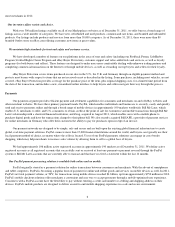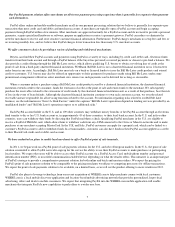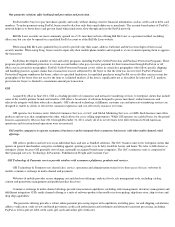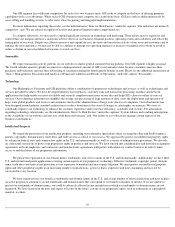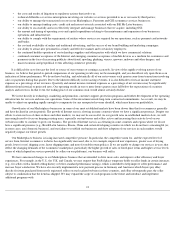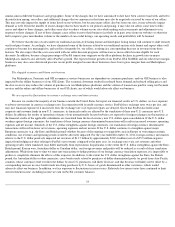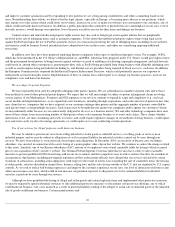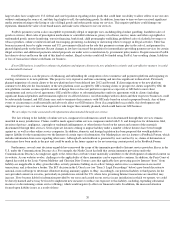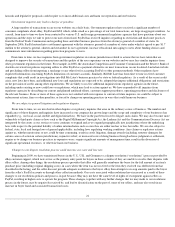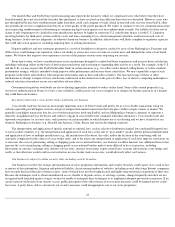eBay 2011 Annual Report Download - page 18
Download and view the complete annual report
Please find page 18 of the 2011 eBay annual report below. You can navigate through the pages in the report by either clicking on the pages listed below, or by using the keyword search tool below to find specific information within the annual report.
It is difficult for us to forecast the level or source of our revenues or earnings accurately. In view of the rapidly evolving nature of our
business, we believe that period-to-period comparisons of our operating results may not be meaningful, and you should not rely upon them as an
indication of future performance. We do not have backlog, and substantially all of our net revenues each quarter come from transactions involving
sales or payments during that quarter. Due to the inherent difficulty in forecasting revenues, it is also difficult to forecast income statement
expenses as a percentage of net revenues. Quarterly and annual income statement expenses as a percentage of net revenues may be significantly
different from historical or projected rates. Our operating results in one or more future quarters may fall below the expectations of securities
analysts and investors. In that event, the trading price of our common stock would almost certainly decline.
We invest heavily in technology, marketing and promotion, customer support, protection programs and further
development of the operating
infrastructure for our core and non-core operations. Some of this investment entails long-term contractual commitments. As a result, we may be
unable to adjust our spending rapidly enough to compensate for any unexpected revenue shortfall, which may harm our profitability.
Growth rates of our Marketplaces businesses in some of our most established markets have been slower than that for ecommerce generally
and have declined in certain periods. The growth of Internet users is slowing in many countries where we have a significant presence. Despite our
efforts to stem our loss of share in these and other markets, we may not be successful. As our growth rates in established markets slow, we will
increasingly need to focus on keeping existing users, especially our top buyers and sellers, active and increasing their activity level on our
websites in order to continue to grow our business. The growth of Internet users is accelerating in some countries and regions where we do not
have a significant presence (e.g., Brazil/Latin America, Russia, China and certain developing countries in which we do not have a meaningful (or,
in some cases, any) domestic business), and our failure to establish our businesses and drive adoption of our services in such markets would
negatively impact our future growth.
Our Marketplaces business is facing increased competitive pressure. In particular, the competitive norm for, and the expected level of
service from, Internet ecommerce websites has significantly increased, due to, for example, improved user experience, greater ease of buying
goods, lower (or no) shipping costs, faster shipping times and more favorable return policies. If we are unable to change our services in ways that
reflect the changing demands of the ecommerce marketplace, particularly the higher growth of sales of fixed-price items and higher service levels
(some of which depend on services provided by sellers on our platforms), our business will suffer.
We have announced changes to our Marketplaces business that are intended to drive more sales and improve seller efficiency and buyer
experiences. For example, in the U.S., the U.K. and Canada, we may request that PayPal place temporary holds on seller funds in certain instances
(e.g., for sellers with a limited selling history or below-standard performance ratings), which is intended to help improve seller performance and
increase buyer satisfaction. We have also recently implemented a new payment process in Germany and Austria in which buyers pay eBay
directly for items purchased from newly registered sellers on our localized websites in those countries, and eBay subsequently pays the seller
subject to confirmation that the item has shipped. We may expand the scope of such programs in the future and introduce and implement
additional programs with
13
•
the costs and results of litigation or regulatory actions that involve us;
•
technical difficulties or service interruptions involving our websites or services provided to us or our users by third parties;
•
our ability to manage the transaction loss rate in our Marketplaces, Payments and GSI ecommerce services businesses;
• our ability to manage funding costs, credit risk and interest-
rate risk associated with our Bill Me Later business;
• our ability to successfully and cost-
effectively integrate and manage businesses that we acquire, including GSI;
• the amount and timing of operating costs and capital expenditures relating to the maintenance and expansion of our businesses,
operations and infrastructure;
• our ability to comply with the requirements of entities whose services are required for our operations, such as payment card networks
and banks;
•
the cost and availability of online and traditional advertising, and the success of our brand building and marketing campaigns;
•
our ability to attract new personnel in a timely and effective manner and to retain key employees;
•
the continued healthy operation of our technology suppliers and other parties with which we have commercial relations;
• continued consumer acceptance of the Internet and emerging consumer acceptance of mobile devices as a medium for ecommerce and
payments in the face of increasing publicity about fraud, spoofing, phishing, viruses, spyware, malware and other dangers; and
•
macroeconomic and geopolitical events affecting commerce generally.



